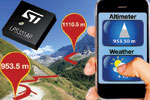

STMicroelectronics has introduced a new pressure sensor that allows portable devices to calculate their vertical elevation relative to sea-level with very high accuracy. This means that the mobile device will know not only on which floor of a building it is located, but almost on which step of the staircase.
Accurate location of mobile devices will be the key enabler for many emerging location-based services (LBS), which are widely expected to be the next wave of ‘killer applications’ in the mobile world. The challenge is to provide the means of identifying the location of the mobile device in three dimensions in a way that meets a variety of conflicting constraints including spatial resolution, reliability, physical size, robustness and cost.
For the horizontal part of the location (latitude and longitude), the universally adopted solution is GNSS (Global Navigation Satellite System), which allows the horizontal position of the device to be calculated to within a metre in optimum conditions where the device can receive signals from four or more satellites.
ST has already demonstrated a solution for indoor navigation developed in conjunction with CSR that can locate devices horizontally and vertically, even in the absence of any satellite signals.
For the third dimension (vertical elevation), atmospheric pressure can provide greater resolution than GNSS – especially when fewer than four satellite signals are visible – as pressure drops steadily with increased elevation.
ST’s new pressure sensor can accurately measure air pressure from 260 millibars, which is the typical air pressure at a height of around 10 km (about 1500 m higher than the summit of Mount Everest) to 1260 millibars, which is the typical air pressure at 1800 m below sea-level, about half the depth of the deepest mine ever dug.
Housed in a tiny 3 x 3 mm package and offering low-voltage operation and low power consumption, the new device is ideal for use in smartphones, sports watches and other portable equipment, as well as in weather stations and automotive and industrial applications. The LPS331AP has already been adopted for use in Samsung’s latest and most advanced smartphone.
The pressure-sensing device is fabricated using a proprietary MEMS technology called ‘VENSENS’, that allows the pressure sensor to be fabricated on a monolithic silicon chip. Manufacturing the device in this way eliminates wafer-to-wafer bonding and maximises reliability.
The sensing element in the LPS331AP is based on a flexible silicon membrane formed above an air cavity with a controlled gap and defined internal pressure. The membrane is very small compared to traditional silicon micro-machined membranes and is protected from breakage by built-in mechanical stoppers.
A piezoresistor, a tiny structure whose electrical resistance varies as the membrane flexes in response to changes in the external pressure, is embedded in the membrane and the change in resistance is monitored, thermally compensated and converted to a digital pressure value that can be read by the equipment’s host processor using the industry-standard I2C or SPI interfaces.
© Technews Publishing (Pty) Ltd | All Rights Reserved